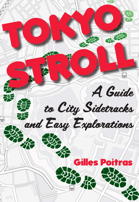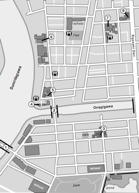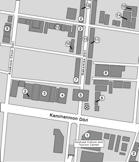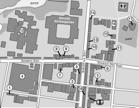











Tokyo Stroll Supplement: Kōkyo (Imperial Palace)

This page indexes, contains corrections and has additions to the Kōkyo (Imperial Palace) chapter of Tokyo Stroll.
For information on Tokyo Stroll and this web supplement see Tokyo Stroll Supplement home page
For users of the Organic Maps, Maps.Me and Google Maps apps the items below have bookmarks you can import into those apps to make navigation easier.
Instructions and links are on the Viewing Locations in Organic Maps, Maps.Me, Google Maps, or Google Earth page.
Some entries on this page may include a note that says "Description to be added soon ." These entries are for items I felt should be listed even if the description is not ready to assist those who wish to plan a trip. When possible I included a link to an official web page, I suggest also doing web searchs for more information.
Chidorigafuchi Moat (千鳥ヶ淵): Tokyo Stroll, Kōkyo (Imperial Palace) Chapter, page 189
NEAREST TRAIN/SUBWAY STATIONS: Kudanshita Station (Toei Shinjuku Line, Tokyo Metro Hanzōmon Line, Tokyo Metro Tozai Line), Hanzōmon Station (Tokyo Metro Hanzōmon Line)
Chidorigafuchi National Cemetery / Chidorigafuchi Senbotsusha Boen (千鳥ケ淵戦没者墓苑): Tokyo Stroll, Kōkyo (Imperial Palace) Chapter, page 189
NEAREST TRAIN/SUBWAY STATIONS: Kudanshita Station (Toei Shinjuku Line, Tokyo Metro Hanzōmon Line, Tokyo Metro Tozai Line), Hanzōmon Station (Tokyo Metro Hanzōmon Line)
WEB: https://www.env.go.jp/garden/chidorigafuchi/english/index.html
Chidorigafuchi Park / Chidorigafuchi (千鳥ヶ淵公園): Tokyo Stroll, Kōkyo (Imperial Palace) Chapter, page 191
NEAREST TRAIN/SUBWAY STATION: Hanzōmon Station (Tokyo Metro Hanzōmon Line)
Dōshin Bansho (同心番所): Tokyo Stroll, Kōkyo (Imperial Palace) Chapter, page 202
NEAREST TRAIN/SUBWAY STATION: Ōtemachi Station (Tokyo Metro Tozai Line, Tokyo Metro Marunouchi Line, Tokyo Metro Hanzōmon Line, Tokyo Metro Chiyoda Line, Toei Mita Line)
Former Imperial Guard Headquarters / Kyū Konoe Shidan Shireibu (旧近衛師団司令部): Tokyo Stroll, Kōkyo (Imperial Palace) Chapter, page 190
NEAREST TRAIN/SUBWAY STATIONS: Kudanshita Station (Toei Shinjuku Line, Tokyo Metro Hanzōmon Line, Tokyo Metro Tozai Line), Takebashi Station (Tokyo Metro Tozai Line)
Fujimi Tamon (富士見多聞): Tokyo Stroll, Kōkyo (Imperial Palace) Chapter, page 203
NEAREST TRAIN/SUBWAY STATIONS: Takebashi Station (Tokyo Metro Tozai Line), Ōtemachi Station (Tokyo Metro Tozai Line, Tokyo Metro Marunouchi Line, Tokyo Metro Hanzōmon Line, Tokyo Metro Chiyoda Line, Toei Mita Line)
Fujimi Yagura (富士見櫓): Tokyo Stroll, Kōkyo (Imperial Palace) Chapter, page 200
NEAREST TRAIN/SUBWAY STATION: Ōtemachi Station (Tokyo Metro Tozai Line, Tokyo Metro Marunouchi Line, Tokyo Metro Hanzōmon Line, Tokyo Metro Chiyoda Line, Toei Mita Line)
Fushimi Yagura (伏見櫓): Tokyo Stroll, Kōkyo (Imperial Palace) Chapter, page 206
NEAREST TRAIN/SUBWAY STATION: Sakuradamon Station (Tokyo Metro Yūrakuchō Line)
Hanzō Gate / Hanzōmon (半蔵門): Tokyo Stroll, Kōkyo (Imperial Palace) Chapter, page 191
NEAREST TRAIN/SUBWAY STATION: Hanzōmon Station (Tokyo Metro Hanzōmon Line)
Hirakawa Gate / Hirakawa Mon (平川門): Tokyo Stroll, Kōkyo (Imperial Palace) Chapter, page 194
NEAREST TRAIN/SUBWAY STATION: Takebashi Station (Tokyo Metro Tozai Line)
Hirakawa Tenmangū (平河天満宮): Tokyo Stroll, Kōkyo (Imperial Palace) Chapter, page 193
NEAREST TRAIN/SUBWAY STATIONS: Hanzōmon Station (Tokyo Metro Hanzōmon Line), Kōjimachi Station (Tokyo Metro Yūrakuchō Line)
Hyakunin Bansho (百人番所): Tokyo Stroll, Kōkyo (Imperial Palace) Chapter, page 201
NEAREST TRAIN/SUBWAY STATION: Takebashi Station (Tokyo Metro Tozai Line)
Imperial Palace / Kōkyo (皇居): Tokyo Stroll, Kōkyo (Imperial Palace) Chapter, page 204
NEAREST TRAIN/SUBWAY STATIONS: Hanzōmon Station (Tokyo Metro Hanzōmon Line), Sakuradamon Station (Tokyo Metro Yūrakuchō Line), Nijūbashimae Station (Tokyo Metro Chiyoda Line), Hibiya Station (Tokyo Metro Hibiya Line, Tokyo Metro Chiyoda Line)
WEB: https://sankan.kunaicho.go.jp/english/guide/koukyo.html
Imperial Palace East Gardens / Kōkyo Higashi Gyoen (皇居東御苑): Tokyo Stroll, Kōkyo (Imperial Palace) Chapter, page 202
NEAREST TRAIN/SUBWAY STATIONS: Takebashi Station (Tokyo Metro Tozai Line), Ōtemachi Station (Tokyo Metro Tozai Line, Tokyo Metro Marunouchi Line, Tokyo Metro Hanzōmon Line, Tokyo Metro Chiyoda Line, Toei Mita Line)
WEB:
https://www.kunaicho.go.jp/e-about/shisetsu/higashigyoen-map.html
Imperial Palace Frontal Plaza / Kōkyo Mae Hiroba (皇居前広場): Tokyo Stroll, Kōkyo (Imperial Palace) Chapter, page 206
NEAREST TRAIN/SUBWAY STATION: Nijūbashimae Station (Tokyo Metro Chiyoda Line), Hibiya Station (Tokyo Metro Hibiya Line, Tokyo Metro Chiyoda Line)
Imperial Palace Main Gate Iron Bridge / Kōkyo Seimon Tekkyō (皇居正門鉄橋): Tokyo Stroll, Kōkyo (Imperial Palace) Chapter, page 206
NEAREST TRAIN/SUBWAY STATION: Sakuradamon Station (Tokyo Metro Yūrakuchō Line)
Imperial Palace Main Gate Stone Bridge / Kōkyo Seimon Ishibashi (皇居正門石橋): Tokyo Stroll, Kōkyo (Imperial Palace) Chapter, page 206
NEAREST TRAIN/SUBWAY STATION: Sakuradamon Station (Tokyo Metro Yūrakuchō Line)
Ishimuro (石室): Tokyo Stroll, Kōkyo (Imperial Palace) Chapter, page 203
NEAREST TRAIN/SUBWAY STATION: Takebashi Station (Tokyo Metro Tozai Line)
JCII Camera Museum / Nihon Camera Hakubutsukan (日本カメラ博物館): Tokyo Stroll, Kōkyo (Imperial Palace) Chapter, page 191
NEAREST TRAIN/SUBWAY STATION: Hanzōmon Station (Tokyo Metro Hanzōmon Line)
WEB:
https://www.jcii-cameramuseum.jp
Kikyō Mon (桔梗門): Tokyo Stroll, Kōkyo (Imperial Palace) Chapter, page 200
NEAREST TRAIN/SUBWAY STATION: Ōtemachi Station (Tokyo Metro Tozai Line, Tokyo Metro Marunouchi Line, Tokyo Metro Hanzōmon Line, Tokyo Metro Chiyoda Line, Toei Mita Line)
Kita Hanebashi Gate / Kita Hanebashi Mon (北桔橋門): Tokyo Stroll, Kōkyo (Imperial Palace) Chapter, page 194
NEAREST TRAIN/SUBWAY STATION: Takebashi Station (Tokyo Metro Tozai Line)
Kitanomaru Park / Kitanomaru Kōen (北の丸公園): Tokyo Stroll, Kōkyo (Imperial Palace) Chapter, page 189
NEAREST TRAIN/SUBWAY STATION: Kudanshita Station (Toei Shinjuku Line, Tokyo Metro Hanzōmon Line, Tokyo Metro Tozai Line)
Museum of Imperial Collections / Sannomaru Shōzōkan (三の丸尚蔵館): Tokyo Stroll, Kōkyo (Imperial Palace) Chapter, page 202
NEAREST TRAIN/SUBWAY STATION: Ōtemachi Station (Tokyo Metro Tozai Line, Tokyo Metro Marunouchi Line, Tokyo Metro Hanzōmon Line, Tokyo Metro Chiyoda Line, Toei Mita Line)
https://www.kunaicho.go.jp/e-event/sannomaru02.html
National Museum of Modern Art (MOMAT) / Tôkyô Kokuritsu Kindai Bijutsukan (東京国立近代美術館): Tokyo Stroll, Kōkyo (Imperial Palace) Chapter, page 190
NEAREST TRAIN/SUBWAY STATION: Takebashi Station (Tokyo Metro Tozai Line)
WEB:
Museum:
http://www.momat.go.jp/english/am/
Restaurant L’Art et Mikuni
http://lart-et-mikuni.jp
National Shōwa Memorial Museum / Shōwa Kan (昭和館): Tokyo Stroll, Kōkyo (Imperial Palace) Chapter, page 185
NEAREST TRAIN/SUBWAY STATION: Kudanshita Station (Toei Shinjuku Line, Tokyo Metro Hanzōmon Line, Tokyo Metro Tozai Line)
WEB: https://www.showakan.go.jp
National Theater of Japan / Kokuritsu Gekijō (国立劇場): Tokyo Stroll, Kōkyo (Imperial Palace) Chapter, page 193
NEAREST TRAIN/SUBWAY STATION: Nagatachō Station (Tokyo Metro Hanzōmon Line, Tokyo Metro Namboku Line, Tokyo Metro Yūrakuchō Line)
WEB:
https://www.ntj.jac.go.jp/english/
NOTE: Temporarily closed. Presently undergoing reconstruction.
Ninomaru Garden / Ninomaru Teien (二の丸庭園): Tokyo Stroll, Kōkyo (Imperial Palace) Chapter, page 203
NEAREST TRAIN/SUBWAY STATIONS: Takebashi Station (Tokyo Metro Tozai Line), Ōtemachi Station (Tokyo Metro Tozai Line, Tokyo Metro Marunouchi Line, Tokyo Metro Hanzōmon Line, Tokyo Metro Chiyoda Line, Toei Mita Line)
Nippon Budōkan (日本武道館): Tokyo Stroll, Kōkyo (Imperial Palace) Chapter, page 188
NEAREST TRAIN/SUBWAY STATION: Kudanshita Station (Toei Shinjuku Line, Tokyo Metro Hanzōmon Line, Tokyo Metro Tozai Line)
WEB:
https://www.nipponbudokan.or.jp/english
Ōte Mon (大手門): Tokyo Stroll, Kōkyo (Imperial Palace) Chapter, page 201
NEAREST TRAIN/SUBWAY STATION: Ōtemachi Station (Tokyo Metro Tozai Line, Tokyo Metro Marunouchi Line, Tokyo Metro Hanzōmon Line, Tokyo Metro Chiyoda Line, Toei Mita Line)
Sakashita Gate / Sakashita Mon (坂下門): Tokyo Stroll, Kōkyo (Imperial Palace) Chapter, page 204
NEAREST TRAIN/SUBWAY STATION: Nijūbashimae Station (Tokyo Metro Chiyoda Line)
Sakurada Gate / Sakurada Mon (桜田門): Tokyo Stroll, Kōkyo (Imperial Palace) Chapter, page 207
NEAREST TRAIN/SUBWAY STATION: Sakuradamon Station (Tokyo Metro Yūrakuchō Line)
Science Museum / Kagaku Gijutsukan (科学技術館): Tokyo Stroll, Kōkyo (Imperial Palace) Chapter, page 190
NEAREST TRAIN/SUBWAY STATIONS: Kudanshita Station (Toei Shinjuku Line, Tokyo Metro Hanzōmon Line, Tokyo Metro Tozai Line), Takebashi Station (Tokyo Metro Tozai Line)
WEB:
https://www.jsf.or.jp
Shimizu Mon (清水門): Tokyo Stroll, Kōkyo (Imperial Palace) Chapter, page 189
NEAREST TRAIN/SUBWAY STATION: Kudanshita Station (Toei Shinjuku Line, Tokyo Metro Hanzōmon Line, Tokyo Metro Tozai Line)
Statue of Kusunoki Masashige (楠木正成像): Tokyo Stroll, Kōkyo (Imperial Palace) Chapter, page 207
NEAREST TRAIN/SUBWAY STATION: Nijūbashimae Station (Tokyo Metro Chiyoda Line), Hibiya Station (Tokyo Metro Hibiya Line, Tokyo Metro Chiyoda Line)
Statue of Ōyama Iwao (大山巌像): Tokyo Stroll, Kōkyo (Imperial Palace) Chapter, page 187
NEAREST TRAIN/SUBWAY STATION: Kudanshita Station (Toei Shinjuku Line, Tokyo Metro Hanzōmon Line, Tokyo Metro Tozai Line)
Suwa no Chaya (諏訪の茶屋): Tokyo Stroll, Kōkyo (Imperial Palace) Chapter, page 200
NEAREST TRAIN/SUBWAY STATION: Takebashi Station (Tokyo Metro Tozai Line)
Tatsumi Yagura (巽櫓): Tokyo Stroll, Kōkyo (Imperial Palace) Chapter, page 200
NEAREST TRAIN/SUBWAY STATION: Ōtemachi Station (Tokyo Metro Tozai Line, Tokyo Metro Marunouchi Line, Tokyo Metro Hanzōmon Line, Tokyo Metro Chiyoda Line, Toei Mita Line)
Tayasu Gate / Tayasu Mon (田安門): Tokyo Stroll, Kōkyo (Imperial Palace) Chapter, page 188
NEAREST TRAIN/SUBWAY STATION: Kudanshita Station (Toei Shinjuku Line, Tokyo Metro Hanzōmon Line, Tokyo Metro Tozai Line)
Tenshudai (天守台): Tokyo Stroll, Kōkyo (Imperial Palace) Chapter, page 195
NEAREST TRAIN/SUBWAY STATION: Takebashi Station (Tokyo Metro Tozai Line)
Tōkagakudō and the Kunaichō Gakubu (桃華楽堂 and 宮内庁楽部): Tokyo Stroll, Kōkyo (Imperial Palace) Chapter, page 195
NEAREST TRAIN/SUBWAY STATION: Takebashi Station (Tokyo Metro Tozai Line)
Yasukuni Shrine / Yasukuni Jinja (靖国神社): Tokyo Stroll, Kōkyo (Imperial Palace) Chapter, page 188
NEAREST TRAIN/SUBWAY STATION: Kudanshita Station (Toei Shinjuku Line, Tokyo Metro Hanzōmon Line, Tokyo Metro Tozai Line)
WEB:
https://www.yasukuni.or.jp
Back to the Tokyo Stroll Supplement home page - Privacy Notice - Back to Gilles' home page
Created May 26, 2022 | Content last updated September 15, 2025